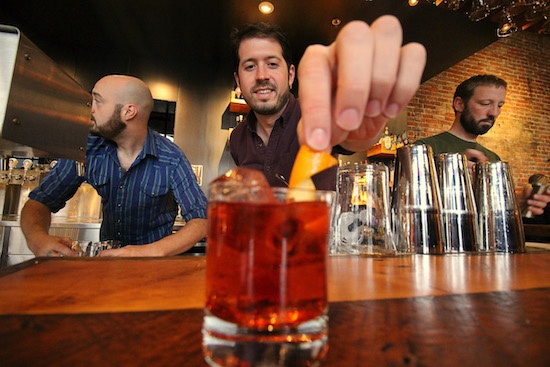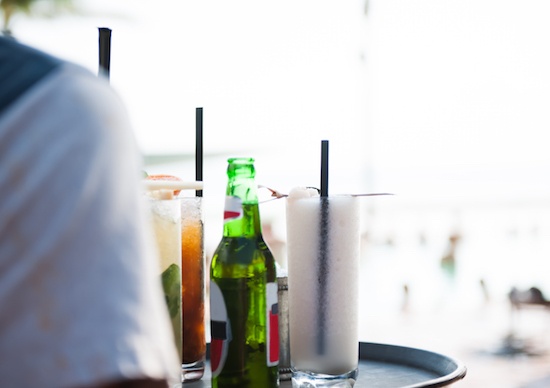Wayfinder Beer in Portland, OR, serves wood-fired comfort food, house and guest beers and innovative cocktails, including several beertails. The man behind the innovation is bartender Jacob Grier, author of Cocktails on Tap: The Art of Mixing Spirits and Beer.
When developing a beer cocktail, Grier (pictured atop) considers how flavors relate. “As with any cocktail, it’s all about pairing flavors that work together and finding the right balance between them,” he notes. Here are some tips from Grier and others on building balanced beer cocktails.
1) Show Some Strength
Beer flavors may be less aggressive than distilled spirits or other cocktail ingredients like bitters and vinegar-based shrubs. But that doesn’t mean that you need to add more of it, Grier says. Rather than flooding a cocktail with mild beer, select strong flavors.
“Most people think of beer cocktails as having beer be the largest volume ingredient in the drink, but a lot of my favorite beer cocktails use only an ounce or so of the beer, mixing it with complementary ingredients,” says Grier. He advises restraint when considering ratios.
“More strongly flavored beers—big IPAs, sours, very dark stouts—can contribute flavor in small amounts. Lighter beers are good for longer drinks, or even for punches,” Grier says. For hot drinks, avoid anything too hoppy or bitter; heat will accentuate those bitter notes, so rich, malty beers are a better bet in those, he notes.
“The beer that you choose should have some bold, crisp flavors of its own so it doesn’t get lost in the cocktail and end up tasting watered down,” says Tracy Ardoin-Jenkins, beverage manager at Italian restaurant Nicky’s Coal Fired in Nashville. “To use beer in a cocktail, you really need to balance it out with strong and bright flavors,” she says.
For instance, “IPAs lend themselves nicely to spicy things like ginger or cinnamon, and something like a witbier would go great with citrus or a nice acidic shrub.”
Ardoin-Jenkins created the Red-Headed Stranger cocktail ($12) with complementary flavors in mind. The drink’s main ingredient is Pimm’s, shaken with lemon juice and ginger syrup, strained into a Collins glass with ice, and topped with IPA.
2) Consult The Classics
When in doubt, refer to classic cocktails as guidelines for what will work with beer. Karen Grill, beverage director at Beer Belly craft beer bar and restaurant, with two locations in the Los Angeles area, looks to the past to inspire future recipes.
“There is a long history of using beer in cocktails that dates back to hundreds of years ago in taverns and homemade punches,” says Grill. “I tend to build on early classics and use beer with complementing flavors to lengthen, sweeten and add effervescence to the cocktail.”
Think about the hop varietals and malts that give the beer its flavor and build from there, Grill adds.
Beer Belly features a rotating beer cocktail, and at press time was serving the LBC Shandy (named for Long Beach, California). Grill builds the drink with fresh lemon juice, honey syrup, peach and sage liqueurs. The ingredients are shaken with and poured over ice, then topped with pilsner and garnished with sage and lemon.
Azu Restaurant and Bar in Ojai, CA, serves farm-driven tapas, cocktails and local wine and beer. Mixologist John Jefferson works with bar manager Richie Smith to design beer cocktails made with proprietary Ojai Valley Brewing beer and fresh produce.
Jefferson, too, espouses the merits of recipe reinvention. “There is a theory that there are no new stories to tell. Everything being a remix of something existing before,” he says. “I believe the same to be true with cocktails.”
Look back at the classics and investigate what makes those drinks work so well, Jefferson says: The ratios will emerge. “Then you remix and remaster those ingredients with all the new, fun stuff available to us today. There is really no end to it.”
One standout beertail at Azu is a modern take on the classic Scotch cocktail Blood and Sand. Blood & Beer, as Azu has named it, blends Chivas Regal Scotch, Luxardo maraschino cherry liqueur and Ojai Valley Brewery’s White Pixie Ale. The combination, served in a nonic half pint over ice, produces a golden ombré hue.
3) Keep In Step With The Season
Shandy-style cocktails may work in climates with mild winters, but they probably won’t sell everywhere in the country.
Knowing when the cocktail will be served will help you select the right components. Once you have determined seasonally appropriate key ingredients, you can fill out the rest of the cocktail recipe with harmonious flavors.
Monnik Beer Co. in Louisville, KY, is a neighborhood brewpub with a casual-cozy ambience. It offers hearty, locally sourced fare, house beer, cocktails and a dedicated lineup of beer cocktails that range in price from $7.50 to $9. Bar manager Jesse Hubbard approaches cocktail design with climate in mind.
The brewpub paints a picture of autumn with Hoodie Weather ($9), a beer cocktail that uses Hauck’s Pils, apple brandy, maple syrup and walnut bitters. “I’m more inclined to use stouts, porters and brown ales in the colder seasons than I am in the summer,” Hubbard says. Fall weather allows for compromise.
As the weather warms, cocktail flavors lighten and brighten. “Pilsners, IPAs and saisons are perfect to use in cocktails during the hot summer months, when everyone’s looking for more refreshing options,” Hubbard says.
“I’ll lean more toward lighter, citrus-infused flavors while featuring more gin and rum options, along with bourbon, of course. Here in Louisville, bourbon is a four-season drink!” Hubbard says.

4) Embrace Aromatics
Beer can provide a wide range of aromatics. At Monnik Beer Co. Hubbard uses a milk stout with intense, roasty notes to embolden his cocktails.
During the winter months he was infusing flavors of smoke, spices and tobacco in cocktails while focusing more on apple brandy or rye whiskey as the main spirit.
One Monnik Beer Co. cocktail, As Thick As Thieves ($8.50), uses Monnik’s His Dark Material milk stout, coffee-infused bourbon, Cynar bitters and raspberry syrup served with an orange peel garnish.
Many of the aromatic components in beer cocktails can also be used as a garnish to give the presentation more character, color and dimension. For example, the aforementioned Red-Headed Stranger cocktail at Nicky’s Coal Fired is served with a mint bouquet garnish, which also serves to marry the spiciness of Pimm’s with piney IPA hop aromatics.
5) Don’t Shy Away From IPA
For those new to crafting beer cocktails, IPA may not be the most obvious beer style to add to a cocktail because of its bitter bite. But beertail veterans find that the hop-forward beer styleworks in a number of recipes and helps enhance the existing aromatics of a drink.
“I love putting hoppy IPAs into tropical cocktails where the floral hop bitterness complements the sweet and spice notes of the drink,” says Grier. IPA makes an appearance in Wayfinder’s Tina Louise ($10), with a Scotch blend, Cascadia d’Amore bitters, lemon, ginger-honey syrup and Peychaud’s bitters.

Conversely, “Darker, maltier styles of beer can work great in winter punches with dark spirits like rum, brandy, or whiskey, and in rich flips made with a whole egg,” says Grier.
Wayfinder’s Averna Stout Flip ($10) incorporates sweet Averna with a toasty stout, Angostura bitters and whole egg; it’s shaken, strained into a glass and garnished with fresh-grated nutmeg.
Don’t overlook less common beer styles either, advises Grill of Beer Belly. She recommends the spontaneously fermented Belgian-style lambic beer, which has a distinctive sour flavor. “Using a lambic beer can sweeten a cocktail and add depth of flavor to dessert-style cocktails,” says Grill.
6) Just Do It
If you haven’t added or expanded a beer cocktail selection, now’s a good time to start. Don’t be intimidated by the process. At Azu Restaurant and Bar, “I use the spaghetti method—throw it at the wall and see what sticks!” says Jefferson.
A more practical approach begins with determining a price point and then building ingredients, ensuring the cocktail will fit within the scope of other menu listings.
“Testing, tasting and experimenting are the way to go. There’s really no wrong way to go about making beer cocktails if you understand the flavor and texture of the beer you’re using,” says Grill.
“There are definitely advantages to offering beer cocktails—especially at a brewery,” says Monnik Beer Co.’s Hubbard. “It’s a fantastic way for the bar program and brewery to promote one another and to feed off of each other’s creativity.”
Erika Bolden is a freelance writer and Certified Beer Server. She is a frequent contributor to L.A. Weekly, West Coaster SoCal and All About Beer magazine.











